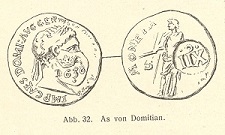
A countermarked Constantine and Gallienus coin
Below are examples of ancient coins in circulation more than 1,000 years after they were minted by the Romans. They were likely recently discovered and re-introduced.
It is very rare to find Late
Roman bronze coins that have been
countermarked.
These two Late Roman bronze coins have been
countermarked
as 4 maravedis
--IIII with
what looks
like a crown
over the top.
I am not
exactly sure
when these
coins were
re-introduced,
but I have
seen similar
countermarks
struck in the
1600's under
Philip IV of
Spain; so over
a thousand
years later
and these two
coins were
circulating
again.
More examples of late circulation
Here is a similar countermark also issued by Spain.

In 1636, a bronze coin of Domitian (81-96AD) was countermarked during the monetary reform of Philip IV, ruler of Spain.
(Blanchet, Sur la chronologie Atablie par les contremarques 1907)
Coins struck under Constantine the Great (323-337AD) were still in circulation in remote places of southern France during Napoleon III. (1852-1870).
Friedensburg, Die Munze in der Kulturgeschichte, pg. 3
In 1916, Arthur E. Robinson was in the Sudan, and his "Nubian" servant brought him some small coins which still circulated west of the Nile. An assortment of the coins consisted of--
Ptolemaic (2 specimens), BM cat. 106, 32-5; Svoronos 1426.
Hadrian (Alex.) BM cat. 346, 21; Dattari 6299.
Probus (Alex.) BM cat. 315, 2435; Svoronos 5557.
Diocletian, BM cat. 324, 2510; Dattari 5693.
Constantine I, not in BM cat.; Dattari 6054.
Turkish, Early Othmanli circ. A.D. 1000 (clipped).
Arthur E. Robinson, "False and Imitation Roman Coins", The Journal of Antiquarian Association of the British Isles 2, no. 3 (1931) : 102.
modified on 11 Dec 2020
